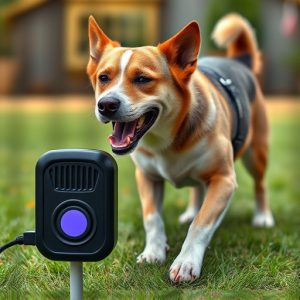Rechargeable vs Disposable: Choosing the Best Dog Repellent Frequency
When choosing between rechargeable and disposable dog repellents, consider long-term cost savings, e…….
When choosing between rechargeable and disposable dog repellents, consider long-term cost savings, environmental impact, power dynamics, safety, and sustainability. Rechargeables offer adjustable frequency settings (20-70 kHz), broader range, reduced e-waste, and budget-friendly upkeep, making them a safer and more eco-friendly choice for outdoor use compared to disposables with shorter lifespans and frequent battery replacements. Always follow manufacturer guidelines for responsible usage in appropriate conditions.
“Uncompromisingly effective dog repellents are essential for maintaining a peaceful environment, especially in shared spaces. This comprehensive guide delves into the heart of dog deterrent technologies, comparing rechargeable and disposable options based on power and cost-effectiveness. We explore the crucial element: frequency range, its impact on performance, and safety considerations. Whether you’re managing a bustling urban area or tackling persistent canine visitors, this article equips you with insights to choose the perfect dog repellent for your needs.”
- Understanding Dog Repellents: The Basics
- Rechargeable vs Disposable: A Cost-Effective Comparison
- Effective Frequency Range: What to Look For
- Safety and Environmental Considerations for Dog Repellents
Understanding Dog Repellents: The Basics
Dog repellents are designed to discourage dogs from entering or occupying specific areas, protecting both property and pets from unwanted interactions. Understanding how they work is crucial when choosing an effective solution. At their core, dog repellents utilise different technologies to emit signals that disrupt a dog’s behaviour. These range from ultrasonic sounds that humans can’t hear but dogs find irritating, to specific frequencies that can deter them without causing harm.
When considering options, one key factor is whether the repellent is rechargeable or disposable. Rechargeable models offer convenience and cost savings in the long term, as they can be used again and again until the battery dies. Disposable power sources, while potentially more expensive upfront, are quick to set up and provide immediate protection. In terms of frequency range, effective dog repellents should target a spectrum that aligns with dogs’ sensitive hearing, usually between 20-70 kHz, with rechargeable models offering the advantage of adjustable settings for tailored control over the intensity and range of the repellent signal.
Rechargeable vs Disposable: A Cost-Effective Comparison
When considering a dog repeller, one of the key decisions is whether to opt for a rechargeable or disposable model. Rechargeable options offer a cost-effective long-term solution as they eliminate the need for constant battery replacements. Over time, this can lead to significant savings compared to disposable alternatives. These devices are often more environmentally friendly too, reducing electronic waste.
On the other hand, disposable dog repellents might be more convenient for short-term use or specific scenarios. They provide immediate protection without the hassle of charging or recharging. However, their frequent need for replacement can make them a pricier choice in the long run. The rechargeable vs disposable debate ultimately hinges on individual needs, budget, and environmental considerations.
Effective Frequency Range: What to Look For
When considering a dog repeller, understanding the effective frequency range is key to ensuring its success. This range refers to the specific frequencies that are used to deter dogs from entering an area. The ideal frequency should be high enough to be unpleasant for dogs but not harmful or uncomfortable for humans and pets.
In terms of rechargeability vs disposable dog repellents, rechargeable options often offer a broader frequency range due to their advanced technology and longer lifespan. This allows users to adjust the settings according to different environments and weather conditions. On the other hand, disposable devices typically have limited power and shorter lifespans, but they can be more convenient for short-term use or areas with lighter dog traffic. Thus, understanding the power and longevity of your chosen device’s batteries is crucial in achieving effective deterrence over time.
Safety and Environmental Considerations for Dog Repellents
Dog repellents, especially those designed for outdoor use, must be chosen with careful consideration for safety and environmental impact. One key aspect to consider is the power source—rechargeable vs disposable. Rechargeable options are generally preferred as they reduce waste and offer a more sustainable solution. Disposable batteries can lead to environmental pollution if not properly disposed of, contributing to e-waste issues. Moreover, using rechargeable dogs repellents can save users money in the long run, eliminating the need for frequent battery replacements.
In terms of safety, it’s crucial to select dog repellents that operate within recommended frequency ranges. Some repellents use ultrasonic sounds or vibrations that are ineffective and potentially harmful to dogs and other animals. Effective repellents often emit specific frequencies tailored to disrupt a dog’s sense of smell or hearing without causing harm. Additionally, responsible users should always follow manufacturer guidelines for usage, ensuring the repellent is suitable for the intended environment and weather conditions.
When choosing a dog repeller, consider both rechargeable and disposable options based on your needs. Rechargeables offer cost savings in the long run, while disposables are more convenient for short-term use. The key to an effective dog repeller lies in its frequency range, ensuring it’s tailored to deter canine intrusions safely and responsibly. Always prioritize environmentally friendly and safe options for both you and your local wildlife.

